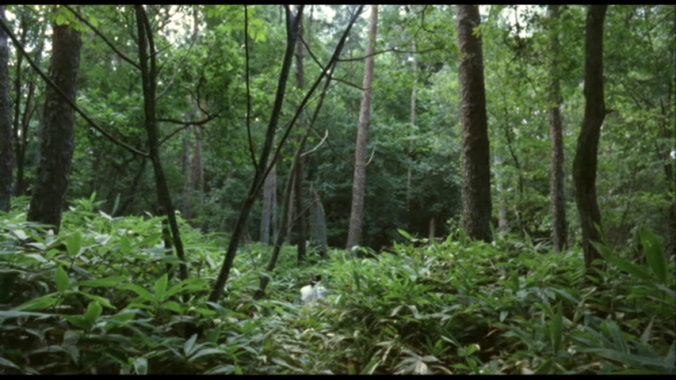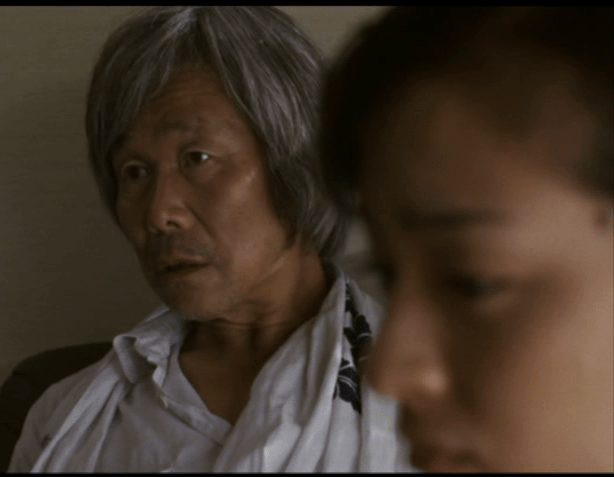 One of the characters in The Mourning Forest says, “There are no formal rules here, you know.” That could be used as a motto for Naomi Kawase’s movie. On the surface it is a simple story of an old man who wanders away from his young caregiver. She gets lost with him in the forest as she desperately tries to find him and bring him back. But this is only the surface. Rather than a simple adventure story of two people lost in the woods, it is a unique adventure of two lost souls desperately looking for a way to end their unbearable internal pain.
One of the characters in The Mourning Forest says, “There are no formal rules here, you know.” That could be used as a motto for Naomi Kawase’s movie. On the surface it is a simple story of an old man who wanders away from his young caregiver. She gets lost with him in the forest as she desperately tries to find him and bring him back. But this is only the surface. Rather than a simple adventure story of two people lost in the woods, it is a unique adventure of two lost souls desperately looking for a way to end their unbearable internal pain.
Machiko is a new worker at a small retirement home, who has lost her young child and as a result her husband. Shigeki is an old man with growing dementia who has never really recovered from the loss of his wife 33 years earlier. Eventually, Machiko takes him in the car for some undefined reason but runs off the narrow country track and gets stuck. As she goes in search of help, he wanders away. After a search through the fields, she finds him stealing a watermelon. Before she can find their way back to the car, he runs into the forest, where she follows. Each time she finds him, he runs away ever deeper, in search of something she does not understand, and they are soon completely lost and caught in a rainstorm as night falls. After a long night, he finds what he is looking for, and surprisingly, Machiko also finds what she didn’t know she was searching for as well.
For the first third of the movie, it looks like an extremely beautiful documentary, with dialogue that seems not only unscripted but simply overheard, sometimes so soft that it is clearer in subtitles than it would have been to a Japanese listener. It is only when Shigeki wanders away from the car that we are certain we are in a fictional film, for even the most callous of documentary film crews would not let their principal subject, an old man with dementia, get out of the car and wander away. They certainly could not conjure up a rainstorm on cue nor change angles on the couple as they wander through the day and night. Even so, it is maintains that sense of documentary reality, never searching for easy explanations or making any clarifying speeches at dramatic climaxes. We have to pay attention.
The home lies deep in the countryside and deep in Buddhism. We first meet Shigeki as he asks a priest visiting the home, “Am I alive?” But this is not merely a philosophical question for him; his mind is now so erratic he is simply not sure where he is. When they practice calligraphy, he writes his dead wife’s name (Mako) over and over, and inks over Machiko’s central character syllable so her name becomes Mako instead. Later the priest comments that after 33 years, the spirit of the dead will join Buddha and can no longer visit the earth. Shigeki’s wife died 33 years earlier, and we will eventually learn that this is part of his reason for running away. Neither the circumstances of her death nor of the death of Machiko’s child are ever given to us in flashback, but it gradually becomes clear that he is searching for a specific tree which he associates with her grave and that Machiko’s child died in a flood of some kind. To go further with explanation would destroy the fascination of the movie.
But this is not merely a philosophical question for him; his mind is now so erratic he is simply not sure where he is. When they practice calligraphy, he writes his dead wife’s name (Mako) over and over, and inks over Machiko’s central character syllable so her name becomes Mako instead. Later the priest comments that after 33 years, the spirit of the dead will join Buddha and can no longer visit the earth. Shigeki’s wife died 33 years earlier, and we will eventually learn that this is part of his reason for running away. Neither the circumstances of her death nor of the death of Machiko’s child are ever given to us in flashback, but it gradually becomes clear that he is searching for a specific tree which he associates with her grave and that Machiko’s child died in a flood of some kind. To go further with explanation would destroy the fascination of the movie.
Kawase made many documentaries and often cast amateurs in her fictional films, so that the unfamiliar faces helped provide a sense of absolute reality. The actors in the movie all use their own names, further underlining the feel of a documentary. Machiko Ono was first seen as a teenager in Kawase’s Suzaku but had begun an active professional career as she grew up. Shigeki Uda was not a professional but a man Kawase had met in a bookshop; he was most definitely not a man fading away with dementia in real life, as evidenced by his occasional appearances in films afterward. Nor could a man in such a state have taken direction. It is the most thoroughly convincing such portrayal I have ever seen, including Iris and Still Alice.
With superb photography by Hideyo Nakano, Mourning Forest is gorgeously set in the fields and mountains of Nara, the site for most of Kawase’s films. Some scenes are formally composed, like the opening Buddhist procession through lush green fields or the hide-and-seek Machiko and Shigeki play among the neat rows of tea plants. Others seem to be caught on the fly by hand-held camera, especially those in the forest or inside the home.
Shigeki leads Machiko on a spiritual journey the viewer does not necessarily understand, for it is personal to him and will only become personal to her in the process. When both finally reach a catharsis, they make no explanation. Kawase simply fades to black and leaves them alone together in the forest. Mourning Forest is an enigmatic yet hypnotic experience for the viewer.



